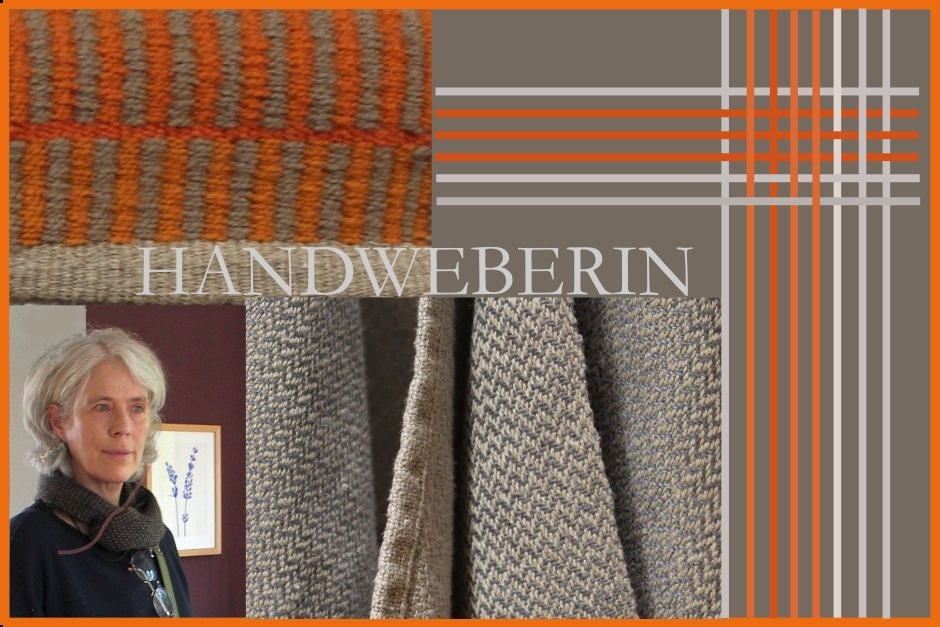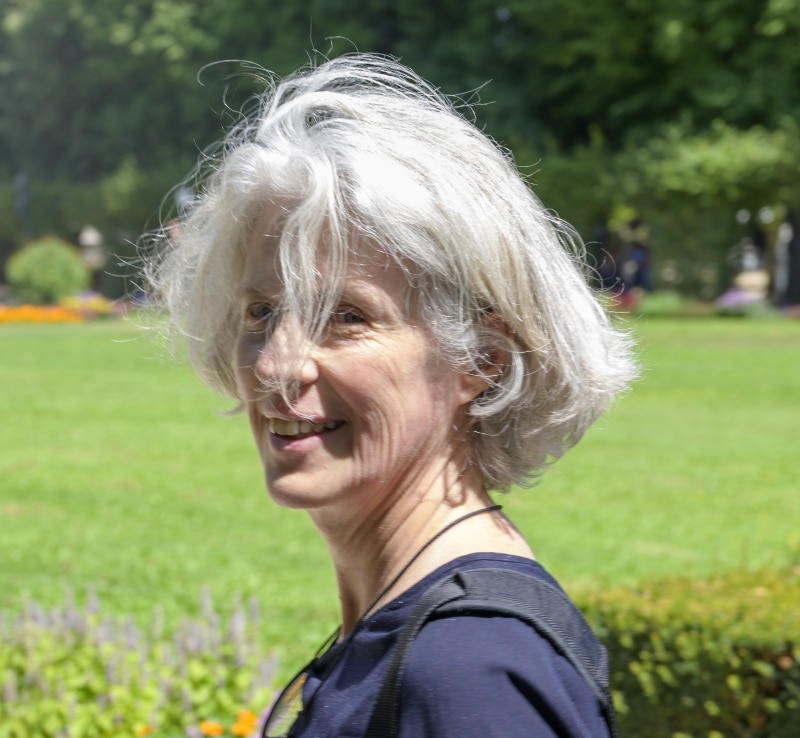
'SLOW Interior Design' for your home!
How does this trend translate into an ancient hand craft - the weaving?
Creating beautiful interior products with a long-lasting design for the home is what Martina Podlewski aspires to do. When she sits down at her loom, she creates locally produced rugs and textiles. Millimeter by millimeter, Martina weaves the next table runner or a new rug for the living area on a weft of pure wool or fine linen. Weaving a textile by hand guarantees the quality of a long-lasting product, but it takes time. As a hand weaver, Martina has that perseverance and dedication.
What is so special about handwoven textiles?
Have you ever dried your hands with a linen towel? Or lounged comfortably in front of a fireplace on a pure wool rug? When Martina talks about her woven interior products, you can feel her love for this ancient craft. With her acquired skills she produces unique interior products made of natural renewable fibres. Her customers know and appreciate the characteristics of her linen towels. They absorb a lot of moisture and due to the robustness of the fiber they are very durable. The woven patterns mix the fine colors of the warp and the weft so that each textile has a unique character. Martina’s densely woven wool rugs show off beautifully on a wooden floor. Especially on a cold stone floor her rugs also create a warming island. Each woven interior product has its own character and exudes a unique vibrancy.
What natural materials does Martina use?
Martina uses virgin wool from Norway for her rugs. She also buys her linen yarn from a European production source. The characteristic shimmer of the linen is due to the smooth surface of the natural fiber. For her chair cushions she uses wool from regional sheep, fabricated in Northern Germany. In addition, she also uses a paper yarn made of 100% cellulose for the edges. Martina thus uses only materials made from renewable raw materials, which are all up-/ recyclable. An important theme that Martina has been implementing for many years.
Wool carpets with a 'feel good' appeal!
At a time when cheaply produced synthetic fiber rugs flood the interior market, Martina makes a conscious counterpoint with her various handmade rug collections.
"My choice of materials and the density of the weft yarns makes it possible for my hand-woven rugs to be passed on to the next generation. That's how durable and robust wool is and the way I weave it. But it takes a few weeks to finish a rug by hand on the loom. My ‘Ritami’ rug collection shows a minimalist and geometric design like a Japanese tatami mat. Variations around a linear design give each rug a unique design. The natural warmth of the wool fiber creates a cosy and warm environment. Not only children enjoy playing on my rugs."
How is a hand-woven product created?
When Martina lets her weaving shuttle whiz back and forth through the taut warp threads on her 1.8-meter-wide wooden loom, it's a fascinating process. How can I weave the weft and warp threads together so that fine textures and structures emerge? Depending on the type of weave Martina chooses, fine 'zigzag twill' patterns, colored stripes or the special 'waffle piqué' look appear on the final textiles. Often, however, the special nature of the material is enough to create an impact like the natural colors, the fine sheen of the plant fibers, the soft warming touch of wool. Alone or in effective contrast, the natural materials give Martina's hand-woven interior products that certain buzz.
What does the design phase look like?
Martina deliberately develops long-lasting designs that retain their value. She tries out colors, patterns and combinations making small woven samples, often translating her colored pencil drawings for a stripe pattern idea. Or she tries out the large-scale stripe sequences of her rugs adapted to the different rug dimensions with a digital drawing. Martina also offers her customers the possibility to adopt some of their ideas to designs of a carpet rug. Martina complements her design ideas with small collages and with the color samples from her yarn catalogues. Question like: How do my selected colors mix in my fine linen fabrics? Or how do I add colorful paper yarn accents to the natural tones of the sheep wool for my seating cushions? Sometimes only trial and error on the loom, sketching on a grand scale and her many years of experience can help to achieve a special interior design.
Martina’s dream - her own large workshop!
After her High school degree in Cologne, Martina does an internship in a hand weaving mill in a country region. Followed by a 3-year apprentice time with a handweaver master in a small town 1,5 south of Cologne. She graduates as a journeywoman with distinction. Then she works as a group leader in the carpet weaving department of a sheltered workshop. To gain an even deeper expertise of her she attends a 1-year master class at a Craft & Design college. While working at different textile companies as a textile designer she misses to handwork on her loom. Weaving her own interior textiles by hand that is more exciting than working in the industry. She continues her handweaving design project in her home studio. In 2015 she gets the chance to rent a big workshop in former Industrial site on the outskirts of Cologne. Finally, her dream comes true. Now she has the space for 2 large looms with the quick shot loom system. Now conversations are no longer possible when Martina is weaving her textiles. the shafts clatter a lot. Remember: weaving has never been a quiet craft!
Exchange and inspiration with other artists
The old industrial brick halls house the studios of many different artists. Conveniently located on the outskirt of Cologne. Twice a year, the open studio days offer a great opportunity to see the work of painters, sculptures and mixed media artists.
"I like to be inspired by the artworks of other artists. Since many people have approached me about 'hand weaving workshops', I am also now offering some 1-day workshops starting in April. I find it exciting how other people deal with the topic 'weaving'. I look forward to the exchange."
The experimenting 'weaving' & the enthusiasm for the craft
Sometimes Martina just enjoys experimenting with the weaving basics. The warp threads form the perfect framework for connecting different materials. This process creates surprising effects. When the stripes of a magazine appear in a linen warp. The various splashes of color and the printed letters come together to create exciting patterns - sometimes as a wall object or table runner. With her enthusiasm for craft, Martina is always open to trying something new. Like she did with the 'Hands on' experiment at the 'Frieder Burda' museum in Baden-Baden, Germany. The Australian sisters Margaret and Christine Wertheim were looking for people to crochet parts of the installation for their artwork 'Value and Change of the Coral reefs'. Their goal is to generate awareness about protecting the great coral reefs. To physically experience how long it takes to crochet one part of the installation makes one aware of how long it takes for a coral to grow. An important ecological statement and handmade experiment based on an ancient craft technique – crocheting
Experience Martina's handwoven interior products in her workshop or in Manuela Larrain Lagos' workshop store 'CucaCucai' in downtown Cologne, the beautiful city with along the Rhine River with the famous cathedral.

Name: Martina Podlewski
She is: artisan hand weaver
She can be found in:
in Cologne, the beautiful city along the Rhine river, where the Romans built the 2nd biggest city besides Rome
'Signalwerk Frechen', Kölner Straße 29-31, 50226 Frechen, Germany
She admires:
- the writer Alice Munro
- the choreographer Anne Teresa De Keersmaeker
- the painter Joan Mitchell
Her WIASOLA tip:
Her favorite museums:
The Frieder Burda Museum in Baden Baden, South Germany
To be found:
She has her studio space in the art center near Cologne city. About 30 artist have their studios in the former industrial site - the 'Signalwerkstatt der Häfen und Güterverkehr Köln AG'.
You can also find a selection of Martina's hand woven textiles in the city center of Cologne _ Werkstattladen ‚CucaCucai‘ by Manuela Larrain Lagos.